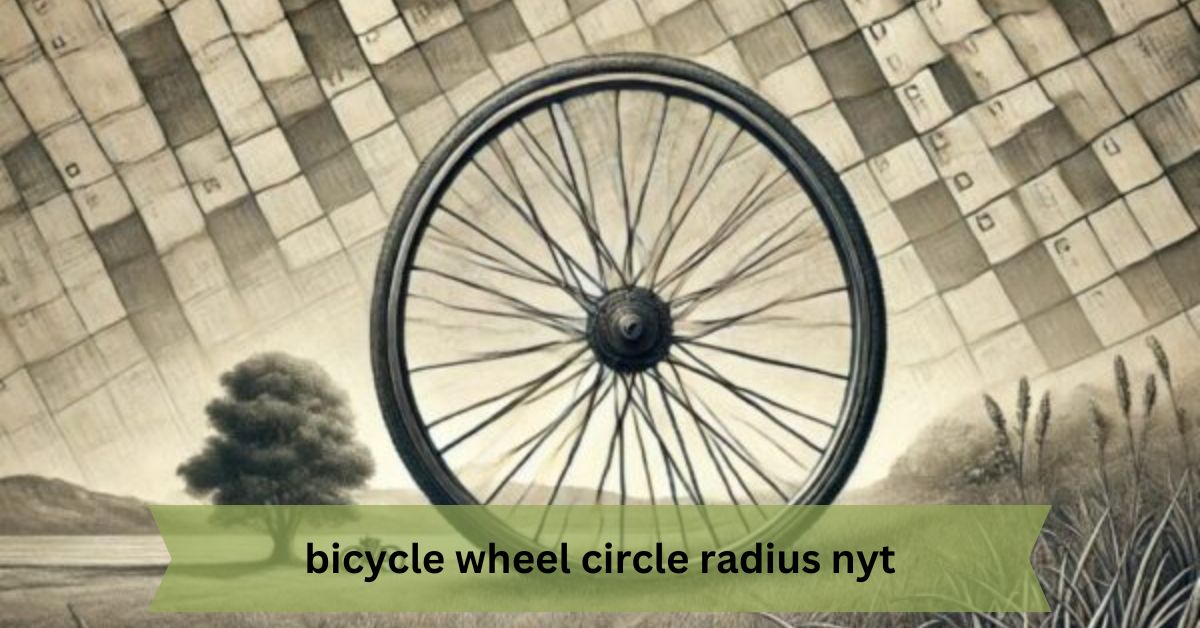In this article, we’ll delve deeper into the bicycle wheel circle radius nyt, exploring its significance in cycling, how it impacts performance, and the mechanics behind it.
What Is the Bicycle Wheel Circle Radius Nyt?
The Bicycle Wheel Circle Radius Nyt refers to the distance from the center of the wheel (the hub) to its outer edge (the tire). Essentially, it’s half of the wheel’s diameter. Understanding this radius is crucial for various reasons, including maintenance, selecting the right tire size, and optimizing the performance of a bicycle.
How Is the Radius Measured?
To measure the bicycle wheel circle radius, you need to first measure the diameter of the wheel. The diameter is the length across the wheel, from one side to the other, passing through the center. The radius is simply half of this distance.
For example, if the diameter of the wheel is 26 inches, the radius would be 13 inches. The concept is straightforward, but it has a significant impact on many aspects of cycling.
The Role of Radius in Bicycle Mechanics
The radius of a bicycle wheel influences several key factors, including:
- Speed and Acceleration: A larger wheel radius allows for smoother and faster rides on flat surfaces, while smaller wheels provide better acceleration.
- Control and Maneuverability: Smaller wheels with a smaller radius allow for more agile turns, making them ideal for mountain biking and off-road cycling.
- Comfort: Larger wheels tend to roll over obstacles more easily, providing a more comfortable ride over rough terrains.
Thus, the radius of a bicycle wheel plays a vital role in determining the type of bike that suits a cyclist’s needs, be it for racing, casual riding, or mountain biking.
The Significance of “Bicycle Wheel Circle Radius” in NYT Crosswords
The New York Times crossword is renowned for incorporating clever wordplay and terms from various subjects, including cycling. One of the most common clues relating to bicycles is “bike wheel radius.” The typical answer to this crossword clue is “spoke.”
Why “Spoke”?
A spoke refers to one of the many rods that connect the wheel’s hub to its outer rim. While the spoke is not the radius itself, it helps support the wheel and maintains its shape, indirectly influencing the radius.
The crossword clue “bike wheel radius” is somewhat metaphorical, as the spoke plays a critical role in the integrity and performance of the wheel, much like the radius.
For crossword enthusiasts, recognizing clues like this can make solving puzzles more enjoyable. Understanding the connection between the mechanical structure of the bicycle wheel and crossword terminology can also make one a better solver of themed puzzles.
The Mathematics Behind Bicycle Wheel Radius
In addition to its physical implications, the bicycle wheel circle radius can be understood mathematically. The most common mathematical concept associated with circles, including bicycle wheels, is the relationship between the radius, diameter, and circumference.
Formula for Circumference:
The circumference (C) of a wheel can be calculated using the formula:C=2×π×rC = 2 \times \pi \times rC=2×π×r
Where:
- rrr is the radius of the wheel
- π\piπ is approximately 3.14159
This formula is important for cyclists who want to track their distance or adjust their bike’s performance. For instance, bike computers and speedometers use the wheel’s circumference to calculate speed and distance.
Practical Example
If the radius of a bicycle wheel is 13 inches, the circumference would be calculated as:C=2×3.14159×13=81.68 inchesC = 2 \times 3.14159 \times 13 = 81.68 \text{ inches}C=2×3.14159×13=81.68 inches
Knowing the circumference allows cyclists to make precise adjustments to their gear settings or monitor their cycling performance with greater accuracy.
Choosing the Right Bicycle Wheel Radius for Your Needs
The size of the bicycle wheel, and therefore its radius, is an essential factor when choosing the right bike. Wheel sizes generally range from 12 inches for children’s bikes to 29 inches for mountain bikes and hybrids. Here’s a quick guide to help you understand which wheel size (and radius) might be right for you:
12-16 Inches (Small Radius)
- Best For: Children’s bikes
- Advantages: Easy to control for young riders, suitable for beginners
- Disadvantages: Slow speed, not suitable for long distances
20 Inches
- Best For: BMX bikes and folding bikes
- Advantages: Great for stunts, easy to maneuver, compact size
- Disadvantages: Limited speed, not ideal for rough terrain
24 Inches
- Best For: Youth mountain bikes
- Advantages: A balance of speed and control, better for off-road riding
- Disadvantages: Less comfortable on long rides compared to larger wheels
26-29 Inches (Large Radius)
- Best For: Mountain bikes, road bikes, and hybrids
- Advantages: High speed, smoother ride over obstacles, more efficient on long rides
- Disadvantages: Harder to maneuver in tight spaces, slower acceleration
Maintaining Bicycle Wheel Radius and Spokes
To ensure that your bicycle rides smoothly, maintaining the integrity of your wheels, particularly the spokes, is essential. Since the spokes are responsible for distributing the tension evenly across the wheel, any issues with them can affect the wheel’s radius, shape, and performance.
Regular Checks for Spoke Tension
One of the key aspects of bicycle maintenance is ensuring that the spokes are properly tensioned. Loose or broken spokes can cause the wheel to wobble or become misaligned, which in turn affects the radius. Regularly check the tension of your spokes and replace any that are damaged.
Truing the Wheel
If the wheel becomes unbalanced or bent, you may need to true the wheel. Truing is the process of adjusting the spokes to bring the wheel back into its correct shape, maintaining the integrity of the radius.
The Impact of Wheel Radius on Cycling Performance
The bicycle wheel circle radius has a direct impact on a cyclist’s performance. A larger radius allows for more distance per pedal rotation, making it easier to achieve higher speeds on flat surfaces. In contrast, a smaller radius offers quicker acceleration but requires more effort to maintain high speeds over time.
Road Cycling
For road cyclists, a larger wheel radius is typically preferred. Larger wheels can roll more efficiently over smooth surfaces, reducing the amount of effort required to maintain high speeds. This is why most road bikes come with wheels that have a larger radius, often around 27 to 29 inches.
Mountain Biking
For mountain bikers, the decision depends on the terrain. A smaller wheel radius offers better control on rough, uneven terrain, making it easier to navigate tight turns and obstacles. Larger wheels, however, are better for covering long distances on more predictable trails.
Commuting
Commuter bikes tend to have medium-sized wheels with a radius that offers a balance between speed and maneuverability. This allows cyclists to navigate through traffic and urban environments while still maintaining a comfortable pace.
FAQs Bicycle Wheel Circle Radius NYT
1. What is the typical radius of a bicycle wheel?
The radius of a bicycle wheel varies depending on the wheel size. For example, a 26-inch wheel has a radius of 13 inches. Road bikes typically have wheels with a radius of 13.5 to 14.5 inches, while mountain bikes range from 12 to 14.5 inches.
2. Why does the “bicycle wheel circle radius” appear in NYT Crossword?
The New York Times crossword often includes clues about bicycles. The term “bicycle wheel radius” usually leads to the answer “spoke,” which refers to the rods that connect the hub to the rim, supporting the wheel’s shape and function.
3. How does the wheel radius affect my cycling speed?
A larger wheel radius allows for more distance per pedal stroke, which means you can achieve higher speeds more efficiently. A smaller radius provides better acceleration but may require more effort to maintain speed over long distances.
4. What is the relationship between the radius and the spoke?
The radius is the distance from the center of the wheel to its outer edge, while the spoke is a rod that connects the hub to the rim. The spokes play a crucial role in maintaining the shape and strength of the wheel, indirectly influencing the radius.
5. How do I maintain the correct radius for my bicycle wheels?
Maintaining the correct radius involves keeping the spokes properly tensioned and ensuring the wheel stays true. Regular maintenance checks and adjustments will help keep the wheel in good condition, preserving its performance.
In conclusion, the bicycle wheel circle radius plays a critical role in both the mechanics of cycling and crossword puzzles. Whether you’re an experienced cyclist looking to optimize performance or someone enjoying a NYT crossword, understanding the wheel’s radius, its mathematical importance, and its impact on riding is essential. By ensuring proper maintenance and choosing the right wheel size, you can improve your overall cycling experience.



